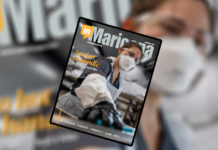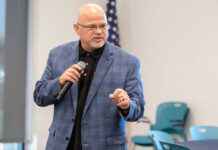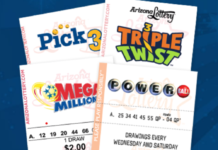
More than 40 trains pass through Maricopa each day, and more are coming. There are approximately 6,000 railroad-crossing accidents each year in the United States involving a motor vehicle and a railroad train.
A motorist is 40 times more likely to die in an accident involving a railroad train than in a collision with another motor vehicle. In 1999, at least 399 people were killed and 1,360 seriously injured in highway-rail crossing collisions.
With the frequency of train traffic in Maricopa, it’s important to take precautions when approaching a railroad crossing. Need more convincing. Check out the following statistics:
Highway-rail facts
• A train strikes either a vehicle or a pedestrian on average of 12 times a day in the United States.
• There are approximately 260,000 public, private and pedestrian at-grade highway-rail crossings in the U.S.
• More people die in highway-rail crossing crashes in the U.S. each year than in all commercial
and general aviation crashes combined.
• Nearly 50 percent of vehicle/train collisions occur at crossings with active warning devices (gates, lights, bells).
• A motor vehicle traveling 50 miles per hour requires approximately 50 feet to come to a stop. A train traveling at 50 miles an hour requires a mile and a half to come to a stop.
Highway-rail terms
• Highway-Rail Grade Crossing – The general area where a roadway crosses a railway, an at- grade crossing of the roadway and the railway.
• Public Grade Crossing – a highway-rail grade crossing where the roadway is under the jurisdiction of and maintained by a public authority.
• Private Grade Crossing – an at-grade crossing where the highway is privately owned and is intended for use by the owner or by the owner’s licensees and invitees. It is not intended for public use and is not maintained by a public highway authority.
• Approximate Number of Highway-Rail Grade Crossings
Public – 158,719
Private – 100,716
• Traffic Control Devices – all signs, signals, markings and devices placed on, over, or adjacent to a street or highway, by authority of a public body or official having jurisdiction to regulate, warn or guide traffic.
• Highway-Rail Crossing Warning Systems – Traffic control devices placed on or adjacent to a highway at, or in advance of, a crossing, including pavement markings and circuitry.
• Active Highway-Rail Crossing Devices – Traffic control devices, which give positive notice to highway users of the approach or presence of a train. Active devices include flashing light signals, automatic gates, and other similar devices activated by a train passing over a detection circuit or, in some instances by manually operated devices.
• Passive Warning Devices – Non-electric traffic control devices, including signs, markings and other devices located at or in advance of a crossing to indicate the presence of a crossing. The purpose is to alert highway users to prepare for and take appropriate evasive action. Passive warning devices include:
• Crossbucks – white reflectorized x-shaped signs with “RAILROAD CROSSING” in black lettering, located alongside the roadway at railroad tracks. Crossbucks should be viewed as a yield sign.
• Advance Warning Sign – a yellow sign with R x R. It is located alongside the highway in advance of the crossing and is designed to notify a motorist of a highway-rail crossing ahead.
• Pavement Markings – markings in advance of the crossing, usually with the legend R x R set into the surface of or applied or attached to the pavement for the purpose of advising, warning or guiding traffic.
Railroad crossing Do’s and Don’ts
Do
• Do obey all railroad grade crossing warning signs, signals, devices and pavement markings.
• Do let ALL trains pass before attempting to cross the tracks.
• Do pay attention when gates are lowered, bells are ringing and/or lights are flashing.
• Do cross railroad tracks only at a railroad grade crossing or a bridge.
• Do understand that railroad-related City ordinances and State statutes will be STRICTLY enforced by police officers.
• Do watch for a second train on the other tracks, approaching in either direction, at a multiple track crossing when waiting for a train to pass.
• Do expect a train at a crossing. Freight trains do not follow set schedules.
• If your vehicle stalls on a railroad crossing, immediately get everyone out of the vehicle and far away from the tracks. Call your local law enforcement agency for assistance.
Don’t
• Don’t ever drive around lowered railroad gates – it’s illegal and deadly. If you suspect a signal is malfunctioning, call the 1-800 number posted on or near the crossing signal or your local law enforcement agency.
• Don’t ever race a train to a crossing – even if you tie, you lose.
• Don’t get trapped on the tracks. Only proceed through a highway-rail grade crossing if you are sure you can completely clear the crossing without stopping. Remember, the train is three feet wider than the tracks on both sides.
• Don’t be fooled by an optical illusion – a train may be closer and moving faster than you think. If you see a train approaching, wait for it to go by before proceeding across the tracks.
• Don’t assume the gates are broken or stuck and pass around them, even if others are doing it.
• Don’t ever use the railroad tracks as a short-cut or as a recreational area upon which to ride a bicycle or take a walk.
• Don’t trespass on any railroad property, including rights-of-way and yards.
• Don’t walk, ride, drive or be upon or along the right-of-way of any railroad tracks. The right-of-way includes the track itself and the roadbed located either side of the tracks.
For additional information and material related to railroad crossing accident prevention, visit
www.operationlifesaver.com.
File photo









![Maricopa restaurateur makes Food Network connection [Namkeen Dhaba]](https://www.inmaricopa.com/wp-content/uploads/2024/04/439456716_377105198650519_7536248579664805896_n-218x150.jpg)
![Merging lanes incite more 347 anger A merging lane sign sits on the side of State Route 347 northbound lanes during evening traffic on April 30, 2024. [Monica D. Spencer]](https://www.inmaricopa.com/wp-content/uploads/2024/04/spencer-043024-adot-merging-lanes-347-web-218x150.jpg)




